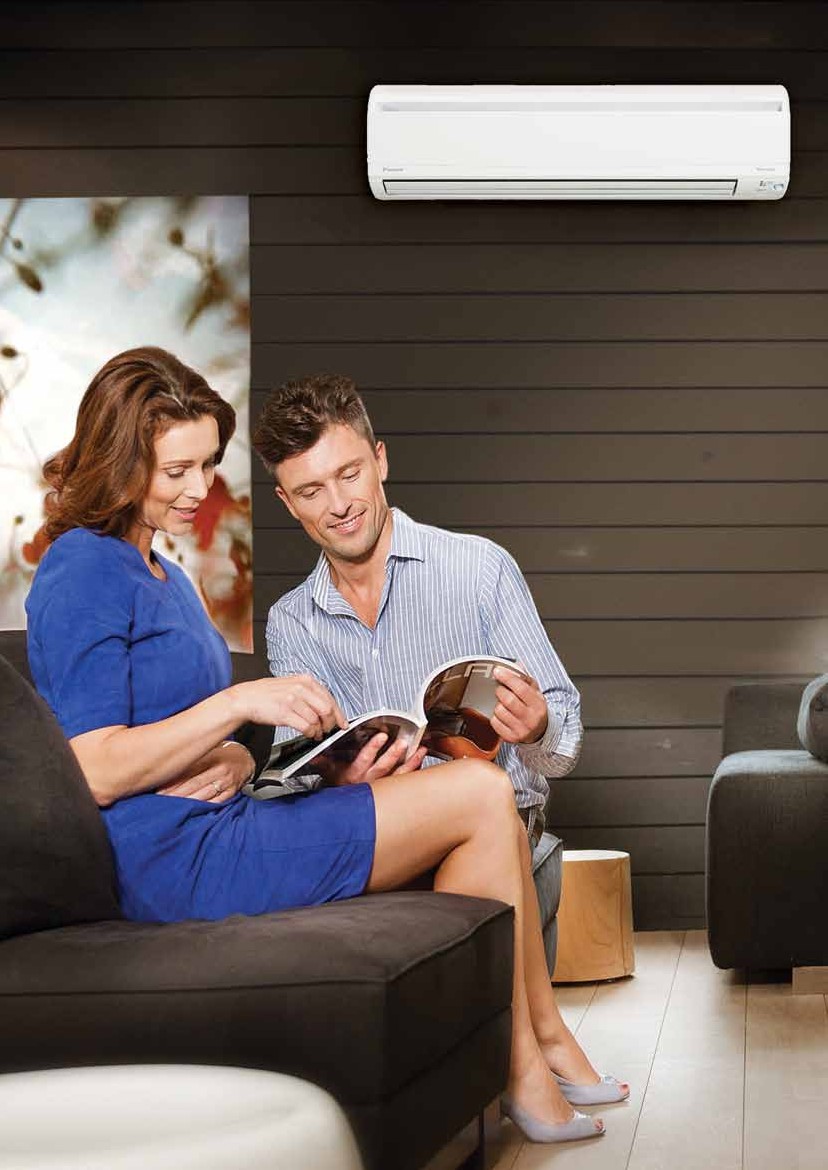
Installing the correctly sized air conditioning unit for your home not only affects the overall cost but also affects running costs.
A unit that is under capacity consumes more power than a correctly sized unit.
The size of the air con unit is only one factor to take into account. Decision making for purchasing a new air conditioning system can be difficult as prices for brands, types, materials and sizes determine the quality of the air conditioning units.
Pricing on ducted systems can vary greatly depending on the brand of unit and type of ancillary equipment used.
Average Running Costs
Daikin’s Research and Development team compared the running costs of an old Daikin split system air conditioner, and a current Daikin model. This comparison was based on delivering identical running times from both options and then calculating the running costs.
| OLD DAIKIN | NEW DAIKIN | |||
| Model: | FTY35F / RY35F | FTXM35Q / RXM35Q (CORA) | ||
| Cooling | Heating | Cooling | Heating | |
| Output (kW): | 3.75 | 4.5 | 3.5 | 3.7 |
| Output over 200 hours (kWh): | 750 | 840 | 700 | 740 |
| Input (kW): | 1.5 | 1.43 | 0.81 | 0.77 |
| Electricity consumption over 200 hours (kWh): | 300 | 286 | 162 | 154 |
| Electricity cost (per kWh): | 27.005c | 27.005c | 27.005c | 27.005c |
| TOTAL COST: | $81.02 | $77.23 | $43.75 | $41.59 |
SAVING = 46%
Electricity tariffs based on NSW Ausgrid / Origin Supply Domestic offers in September 2016.
The good news is ….
advances in Daikin’s split system air conditioning technologies have greatly improved energy efficiency:
- Inverter technology– An advanced fan motor technology which allows the unit to operate more efficiently than other models. This technology enables the desired temperature to be reached faster, and steadily maintains the temperature without fluctuations.
- Reluctance DC motor– The motor utilises powerful neodymium magnets that are 10 times stronger than conventional ferrite magnets. By maximising torque, Daikin’s reluctance DC motor can boost efficiency by 20% higher than conventional motors.
- Econo mode– Helps reduce power consumption and decreases the load on the electrical circuit when multiple electrical devices are used simultaneously.
- Standby power function– when the air conditioner is not in use, the standby power function turns off power supply to the outdoor unit and sets the indoor unit into standby mode, reducing energy consumption.
- Intelligent eye (available on some models)– An infrared sensor that detects human movement. If the room is unoccupied for more than 20 minutes, the system automatically changes to energy saving operation.
What’s more…
You’ll enjoy all these other benefits with a Daikin split system:
- Better air quality– The only split system air conditioning brand to be recognised by the National Asthma Australia’s Sensitive Choice Program.
- Comfort mode– Guarantees draft-free operation by positioning the louvre downwards to drive cool air to the bottom of the room.
- 24 hour on/off timer– The timer can be pre-set to start and stop at any time within a 24-hour period.
- Powerful mode– If you need to heat the room quickly, powerful mode maximises power for 20 minutes, before automatically returning the unit to the original setting.
- Smart phone control (optional)– Daikin’s D-mobile app allows you to monitor and control your split system from virtually anywhere.
When the running cost of a new Daikin split system air conditioner can be up to 46% less the cost of an old Daikin split system, Australians need to look at the possibilities.
Take this opportunity to speak to ACSIS Airconditioning about replacing your split system old air conditioner today.
Average Running Costs
Daikin’s Research and Development team compared the running costs of an old Daikin ducted air conditioning system, and a current Daikin model. This comparison was based on delivering identical running times from both options and then calculating the running costs.
| OLD DAIKIN | NEW DAIKIN | |||
| Model: | FDY125FV1B / RY125KUY1 | FDYQ140LBV1 / RZQS140AV1 (Premium Inverter) | ||
| Cooling | Heating | Cooling | Heating | |
| Output (kW): | 12.96 | 13.63 | 14 | 16.5 |
| Output over 200 hours (kWh): | 2592 | 2726 | 2800 | 3300 |
| Input (kW): | 5.72 | 5.51 | 4.13 | 4.29 |
| Electricity consumption over 200 hours (kWh): | 1144 | 1102 | 826 | 858 |
| Electricity cost (per kWh): | 27.005c | 27.005c | 27.005c | 27.005c |
| TOTAL COST: | $308.94 | $297.60 | $223.06 | $231.70 |
SAVING = 25%
Electricity tariffs based on NSW Ausgrid / Origin Supply Domestic offers in September 2016. FDYQ140 selected to provide equivalent capacity to 2000 model FDY125.
Rated values on FDY125FV1B / RY125KUY1 at 13.5kW adjusted by 4% to likely actual value of 12.96kW. Prior to the Minimum Energy Performance Standards (MEPS) regulations, there was some performance overstating by the market. Rated Capacity on FDYQ140LBV1 / RZQS140AV1 (inverter) was reduced to match capacity of 2000 model.
The good news is ….
advances in Daikin’s ducted air conditioning technologies have greatly improved energy efficiency:
- Inverter technology – An advanced fan motor technology which allows the unit to operate more efficiently than other models. This technology enables the desired temperature to be reached faster, and steadily maintains the temperature without fluctuations.
- DC indoor fan motor – Daikin’s indoor units are equipped with a variable speed high efficiency DC fan motor. By utilising high power permanent magnets instead of the induced magnetism of conventional AC motors, Daikin’s DC motor can deliver significantly higher motor efficiency.
- Automatic Mode Changeover – automatically selects heating and cooling modes to suit thermostat settings and the current room temperature.
- Predicted Mean Vote (PMV) control – Measures the indoor and outdoor temperatures to calculate the ideal room temperature and gently adjusts it for optimum balance between efficiency and comfort.
- Temperature limit operations – lets you pre-define the temperature range for both heating and cooling to reduce energy consumption.
- Home leave – ideal for cold climates, when activated, home leave turns your air conditioner on automatically when room temperatures drop below 10°C, keeping your home at or above 10°C.
What’s more…
You’ll enjoy all these other benefits with a Daikin ducted system:
- Night quiet mode – Outdoor unit noise is automatically reduced by 3 dB when outdoor temperatures fall more than 6°C from the day’s maximum (set during installation).
- Intelligent defrost – During heating operation in low ambient temperature conditions, frost can form on the outdoor unit heat exchanger which can reduce your air conditioners performance. Daikin’s intelligent defrost system constantly monitors a range of system parameters and temperatures to determine optimum time to commence a defrost operation for maximum performance in cold conditions.
- 24 hour on/off timer – The timer can be pre-set to start and stop at any time within a 24-hour period.
- Hot start – Prior to heating, the indoor unit warms to a pre-set temperature before the fan switches on, ensuring only warm air is discharged and eliminates cold drafts.
- Quick cool/heat – Powerful Mode – If you need to heat the room quickly, powerful mode maximises power for 20 minutes, before automatically returning the unit to the original setting.
- Smart phone control (optional) – Daikin’s SkyFi app allows you to monitor and control your ducted system from virtually anywhere.
When the running cost of a new Daikin ducted system air conditioner can be up to 25% less the cost of an old Daikin ducted system, Australians need to look at the possibilities.
Take this opportunity to speak to ACSIS Airconditioning about replacing your ducted system old air conditioner today.
Examples of Air Conditioner Price Differences
- A Daikin 14kw Premium Inverter operating on 7 zones and 12 outlets with a MyAir5 controller and temp sensors to each zone is $1700 more than the same Daikin unit using the Zone6 controller.
- A Mitsubishi(MHI) unit with the same capacity using the Zone6 controller is $2500 less than the Daikin/MyAir5 combination. The price difference is mainly attributed to the unit & controller cost only as the balance of material and labour costs remain almost the same.

Want to Buy an Air Conditioner in Perth?
The following considerations should be taken into account:
- Brand of unit – Can affect overall cost.
- Size of unit – Can affect cost, running costs and performance.
- Type of controller – Can affect cost and performance.
- Quality of ductwork and fittings – Affects price, performance and reliability.
At ACSIS Air we are able to design and install systems to suit most budgets whether it’s a top of the range Daikin unit with the MyAir controller or a Mitsubishi unit with the basic controller.
If you want to know more about our air conditioning prices in Perth, please feel free to contact us anytime on (08) 9331 4366!
